Event Loop - 事件佇列
阿新 • • 發佈:2020-12-02
# Event Loop
### 定義:
event - 事件 loop - 迴圈,既然叫事件迴圈,那麼迴圈的點在哪?
迴圈的是一個又一個的任務佇列,這些任務佇列由巨集任務和微任務構成
### 兩條原則
1. 一次處理一個任務
2. 一個任務開始後直到完成,不會被其他任務中斷
### 事件處理之間的關係
一次事件處理中,最多處理一個巨集任務,但是會處理所有的微任務,任務開始後,會將內部所有的巨集觀函式加到巨集觀佇列等待,會將所有的圍觀函式加到微觀佇列等待,當前巨集任務處理完畢後,開始逐個處理微任務,當微任務執行處理完成,會檢查是否需要更新ui,如果是則重新渲染ui。之後再次檢查巨集觀任務佇列中的下一個巨集觀任務,取出來並且執行
### 執行規則
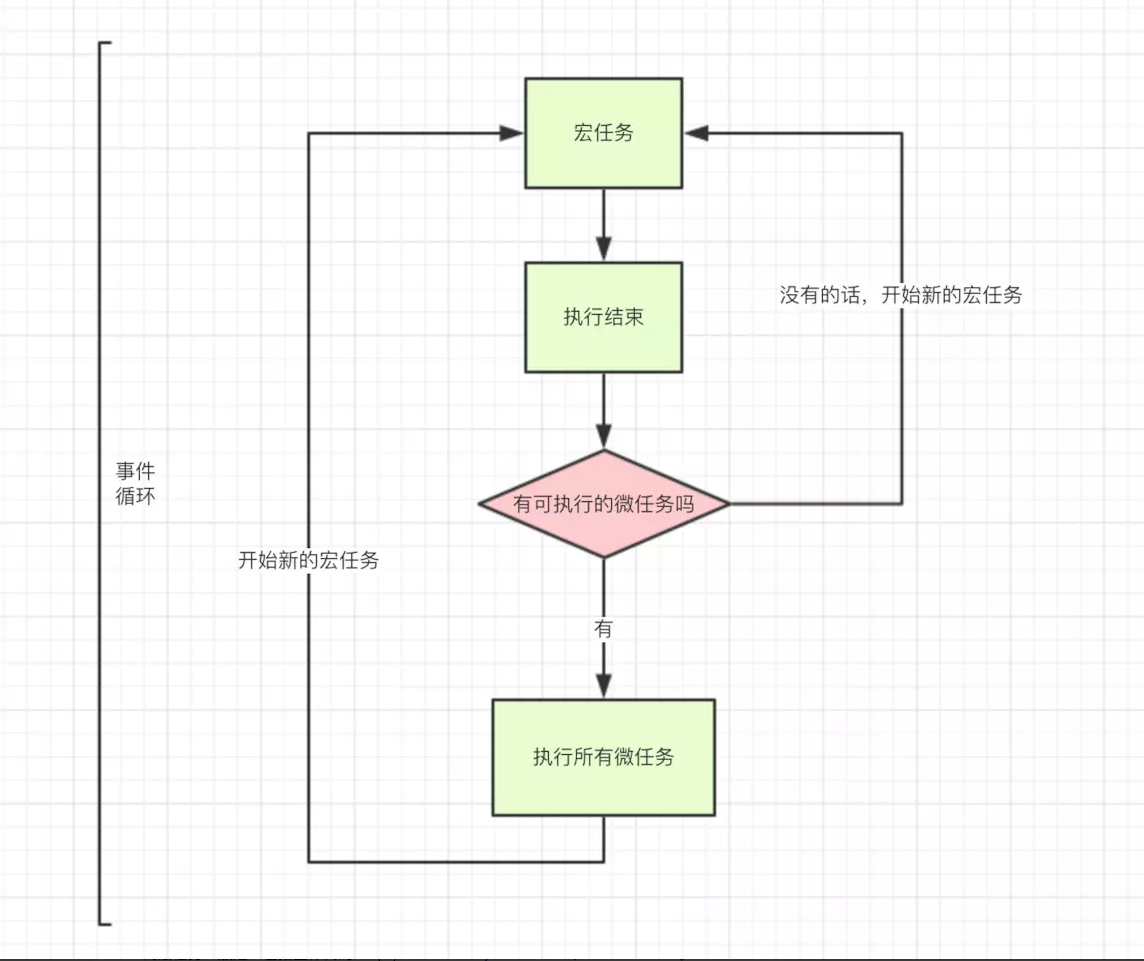
### 巨集任務包含:
1. 整體script(也叫js主程序)
2. settimeout
3. setinterval
4. requestAnimationFrame
### 微任務包含:
1. Promise.then catch finally
2. Generator 函式
3. async/await
4. MutationObserver
### 非同步任務都有哪些
1. 回撥函式
2. Promise(注意new promise裡面的屬於同步任務)
3. async
4. Generator
5. 事件監聽
6. 釋出/訂閱
7. 計時器
8. requestAnimationFrame
9. MutationObserver
### 題外話
瀏覽器的渲染,不同瀏覽器處理是不同的,但是大部分瀏覽器選擇一般是一秒鐘60幀率(也就是60fps),這意味著瀏覽器會在16ms左右渲染一幀,所以我們單個任務和該任務的所有附屬微任務都應該在16ms內完成,以達到顯示平滑流暢。
### 怎麼證明js事件佇列存在,就拿簡單的setTimeout來說
```
console.time("settimeout");
setTimeout(() => {
console.log('settimeout執行')
console.timeEnd("settimeout");
}, 1000);
for (let a = 0; a < 50000; a++) {
console.log(a)
}
```
time會輸出多少呢?這種事件是怎麼觸發的?
程式碼是在一秒鐘後才加入事件佇列,之後等待執行。怎麼證明,很簡單我們在拿出一個定時器
```
console.time("settimeout");
console.time("settimeout2");
setTimeout(() => {
console.log('settimeout執行')
console.timeEnd("settimeout");
}, 1000);
setTimeout(() => {
console.log('settimeout2執行')
console.timeEnd("settimeout2");
}, 1);
for (let a = 0; a < 50000; a++) {
console.log(a)
}
```
明明後宣告的定時器2,卻先執行了,不知道有沒有發現,定時器1和定時器2執行時間,很接近!!!這很重要,為什麼會這樣,這就是今天所說的事件佇列,當1毫秒時候,定時器2被加入了事件佇列,當一秒鐘時候定時器1被加入事件佇列,然後for執行完後,佇列中下一個任務為定時器2,但是他只有一個console故而很快,所以拿出了定時器進行執行。再來看個額外例子,來鞏固下:
```
console.time("settimeout");
console.time("settimeout2");
setTimeout(() => {
console.log('settimeout執行')
console.timeEnd("settimeout");
}, 1000);
for (let a = 0; a < 50000; a++) {
console.log(a)
}
setTimeout(() => {
console.log('settimeout2執行')
console.timeEnd("settimeout2");
}, 1);
```
枯燥無味的定義基本就這樣,我們來從實踐來做分析
從練習題來說
```
console.log(1)
setTimeout(function () {
console.log(2)
setTimeout(function () {
console.log(3)
})
})
setTimeout(function () {
console.log(4)
})
console.log(5)
```
第一次執行之後
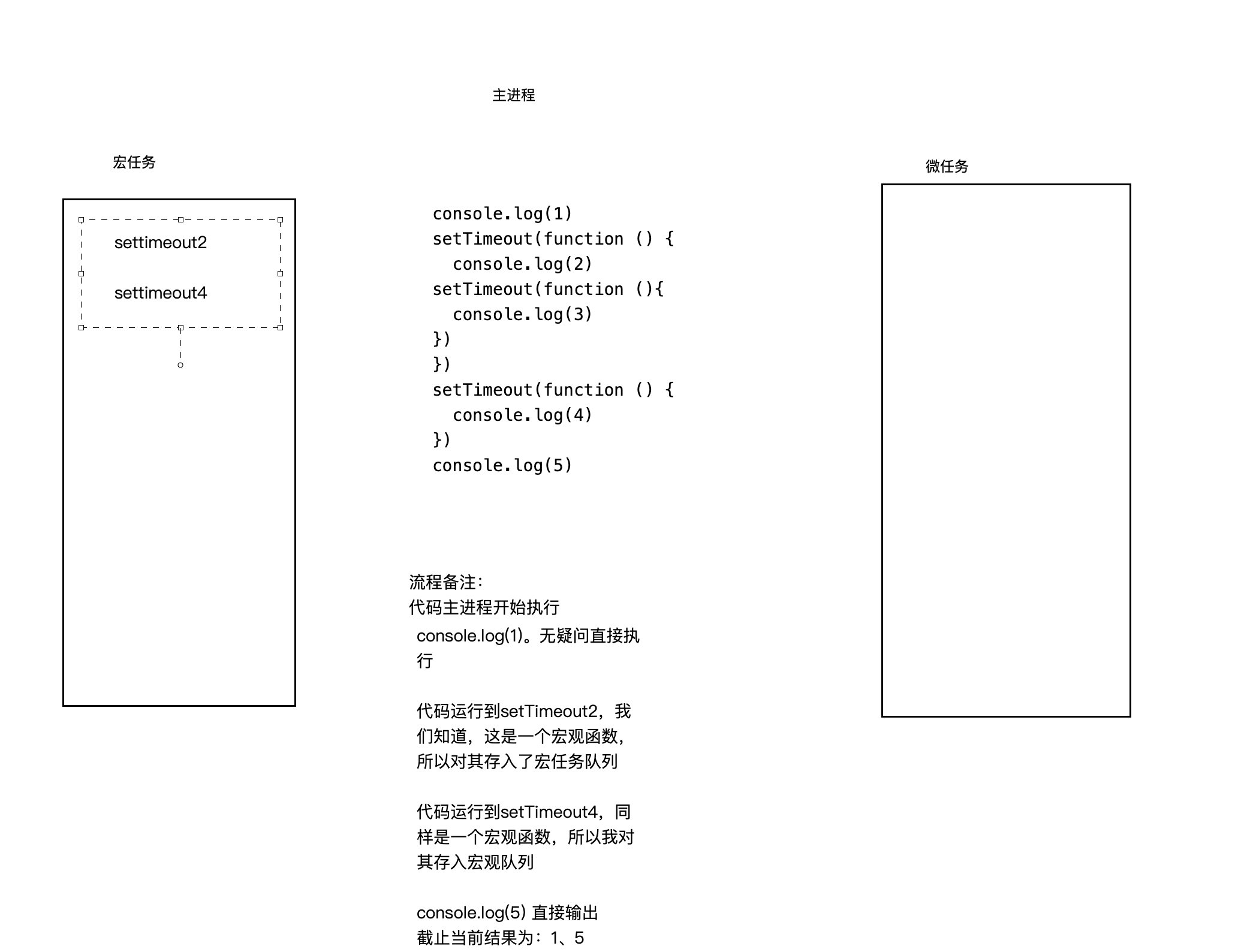
這時當前主程序佇列已經結束,開始檢測微任務佇列是否還有未完成的任務,發現微任務佇列已經空了所以,當前巨集任務佇列結束,開始下一組巨集任務
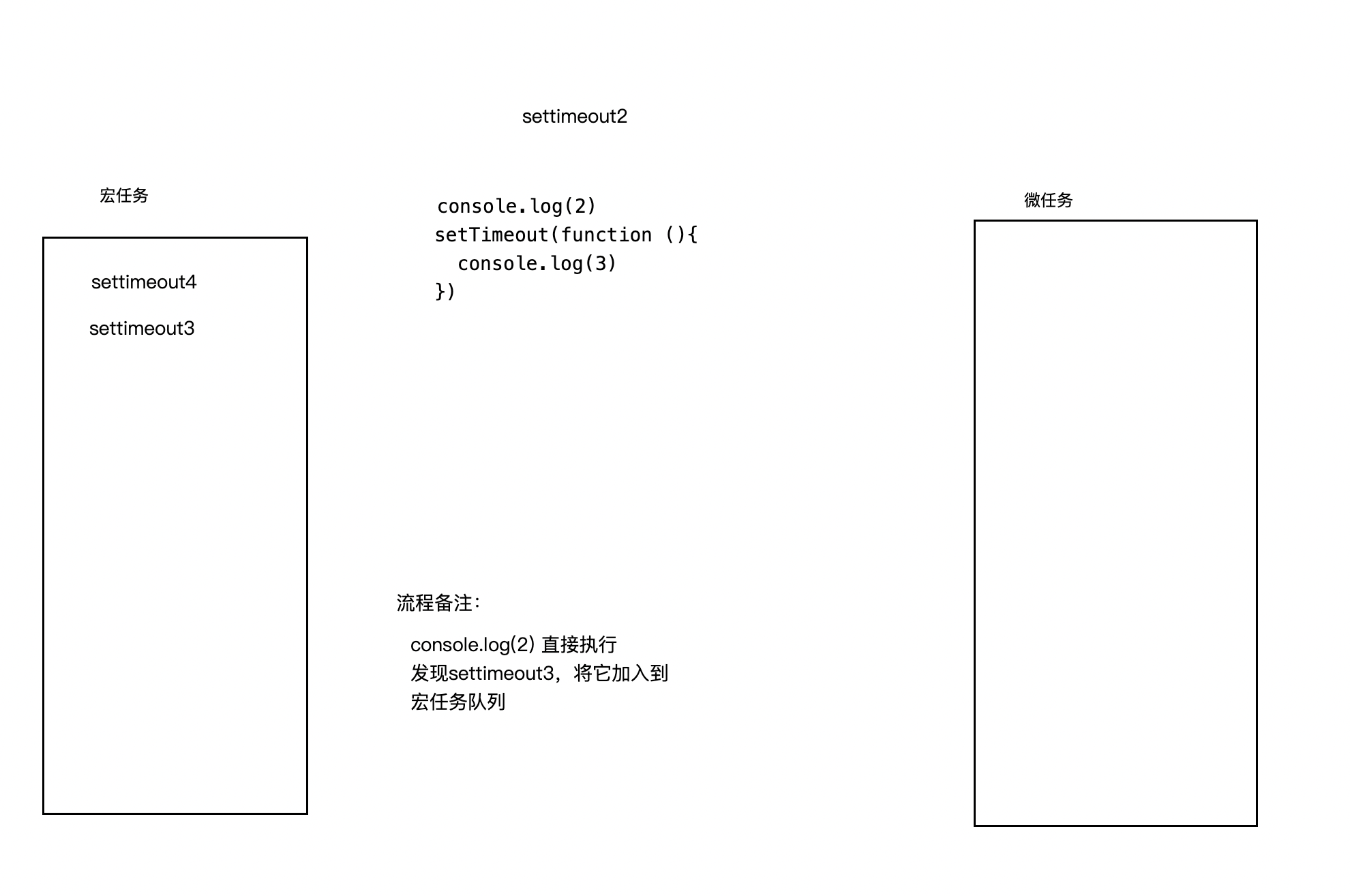
settimeout2任務完結,檢查當前微任務佇列為空,開始下一組巨集任務
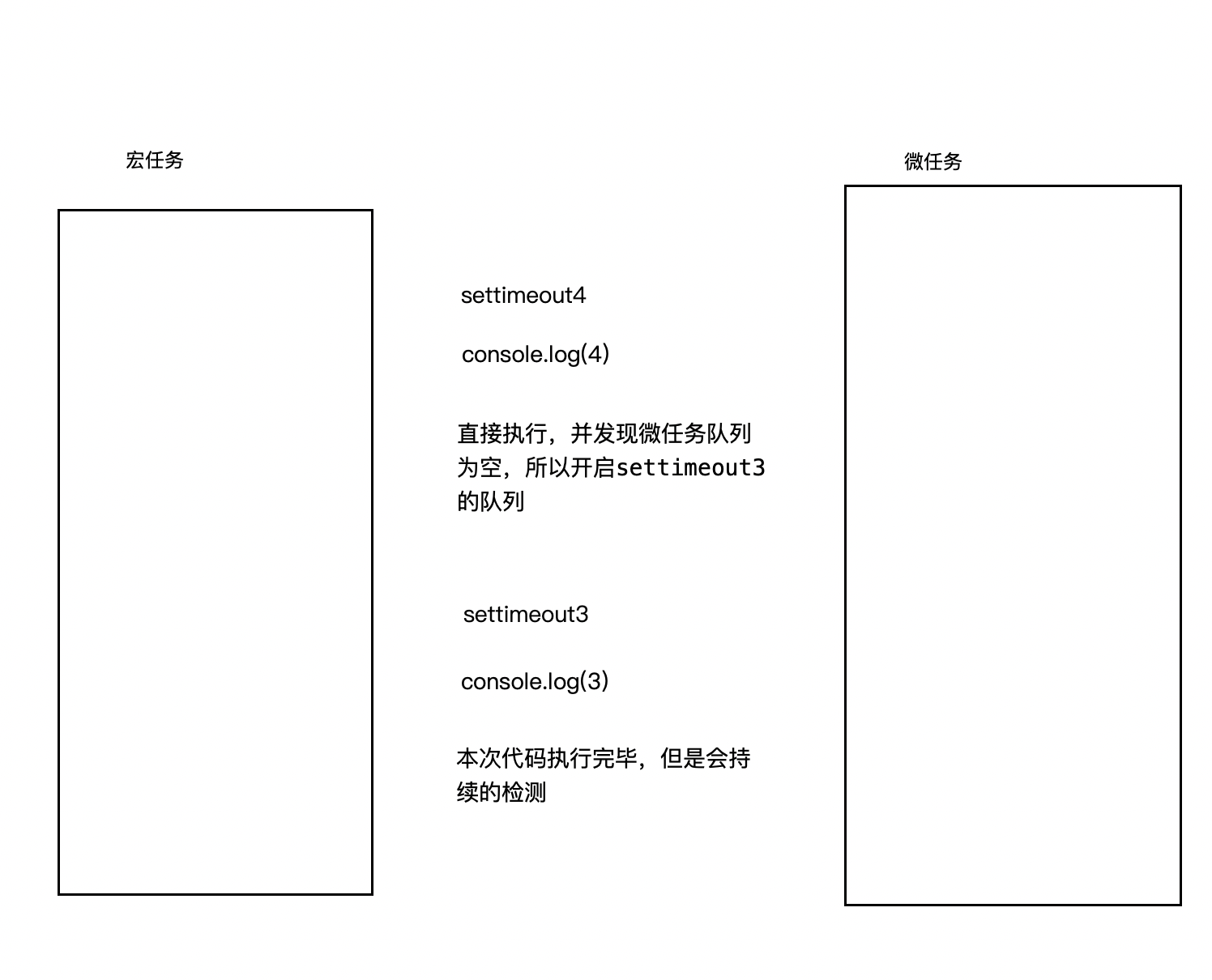
所以最終答案為:
1,5,2,4,3
- 注意:setTimeout是以其觸發事件為寫入佇列時間。如果這麼說不理解的話 可以將上面程式碼改為如下:
```
console.log(1)
setTimeout(function () {
console.log(2)
setTimeout(function () {
console.log(3)
})
})
setTimeout(function () {
console.log(4)
})
console.log(5)
```
這樣就會輸出1,5,2,3,4
tips: setTimeout寫的1000不等於他就是在上一次事件結束後的1000ms,而是以他宣告開始就進行計時的。不過這不是本篇文章的核心,我們不深究他的邏輯,繼續看第二個例子
```
console.log(1)
setTimeout(() => {
console.log('2')
Promise.resolve(4).then((res) => console.log(res))
}, 0);
setTimeout(() => {
console.log('3')
}, 0);
```
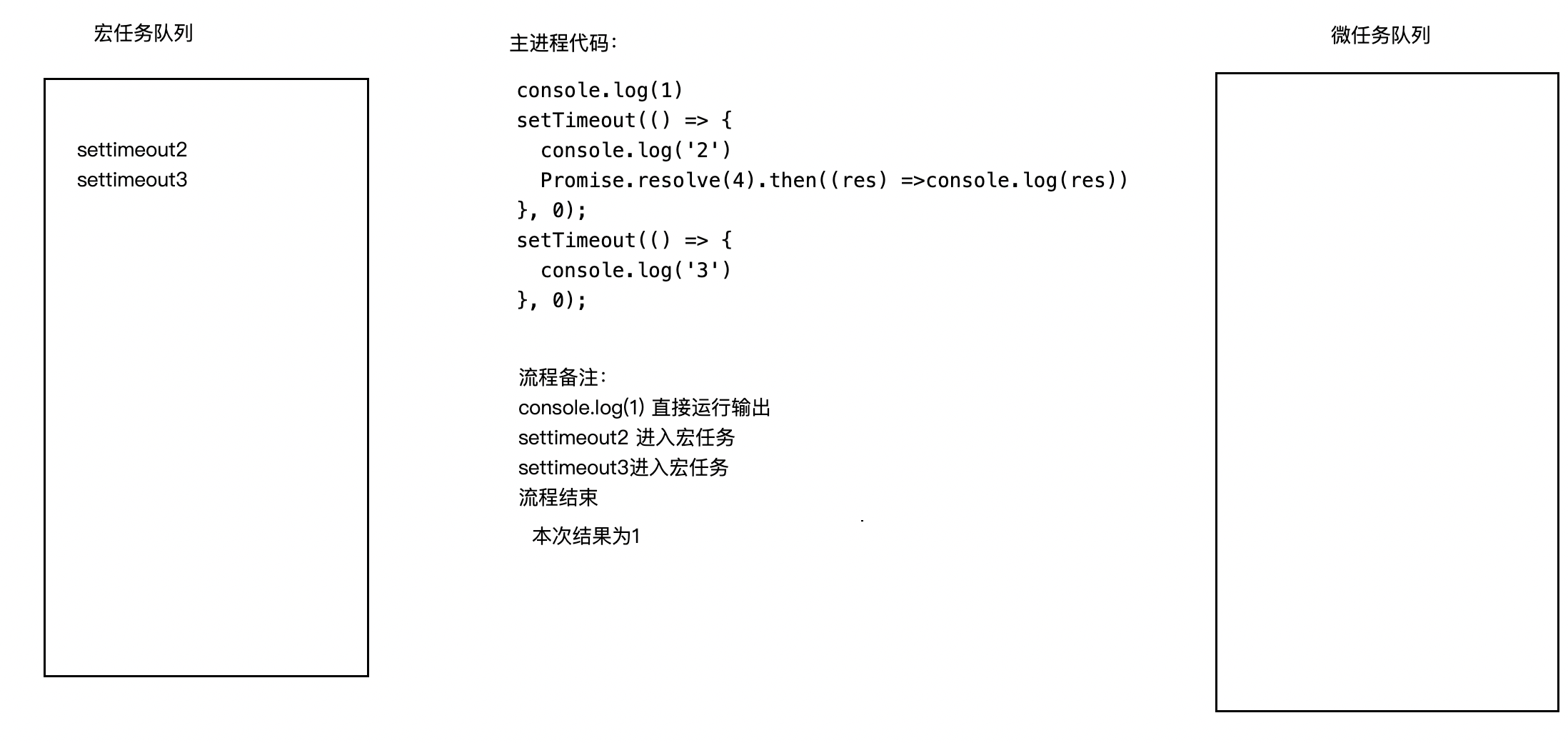
主程序執行完畢,檢查微任務佇列為空,當前巨集任務結束,開啟下一組巨集任務
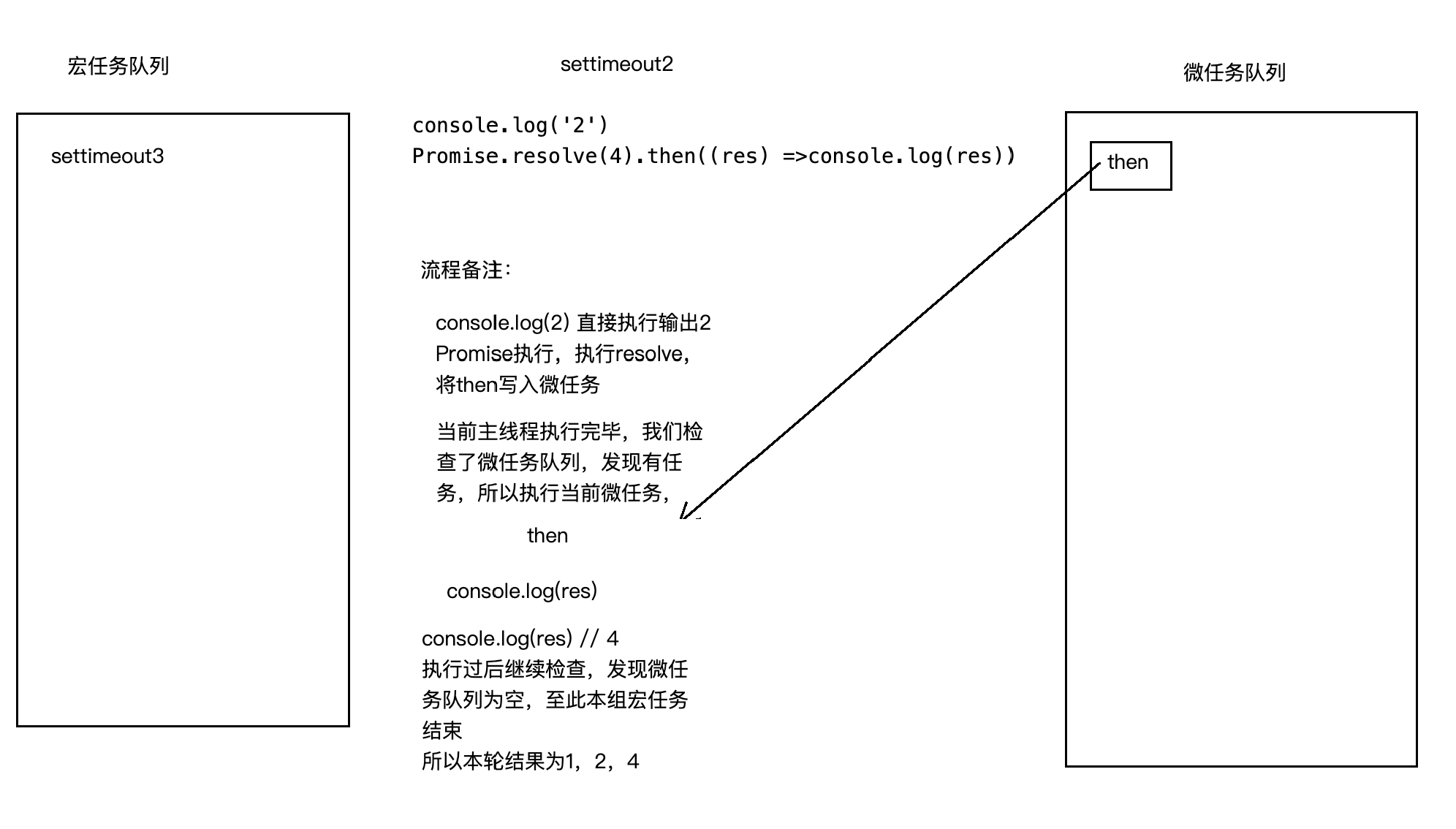
settimeout巨集任務執行完畢,檢查巨集任務佇列,拿出settimeout3的巨集任務,將它拿出來執行。這個比較簡單咱們就不畫圖了
所以本題答案為1,2,4,3
```
let promise = new Promise(function(resolve, reject) {
console.log('1');
resolve();
});
promise.then(function() {
console.log('2');
});
console.log(3)
```
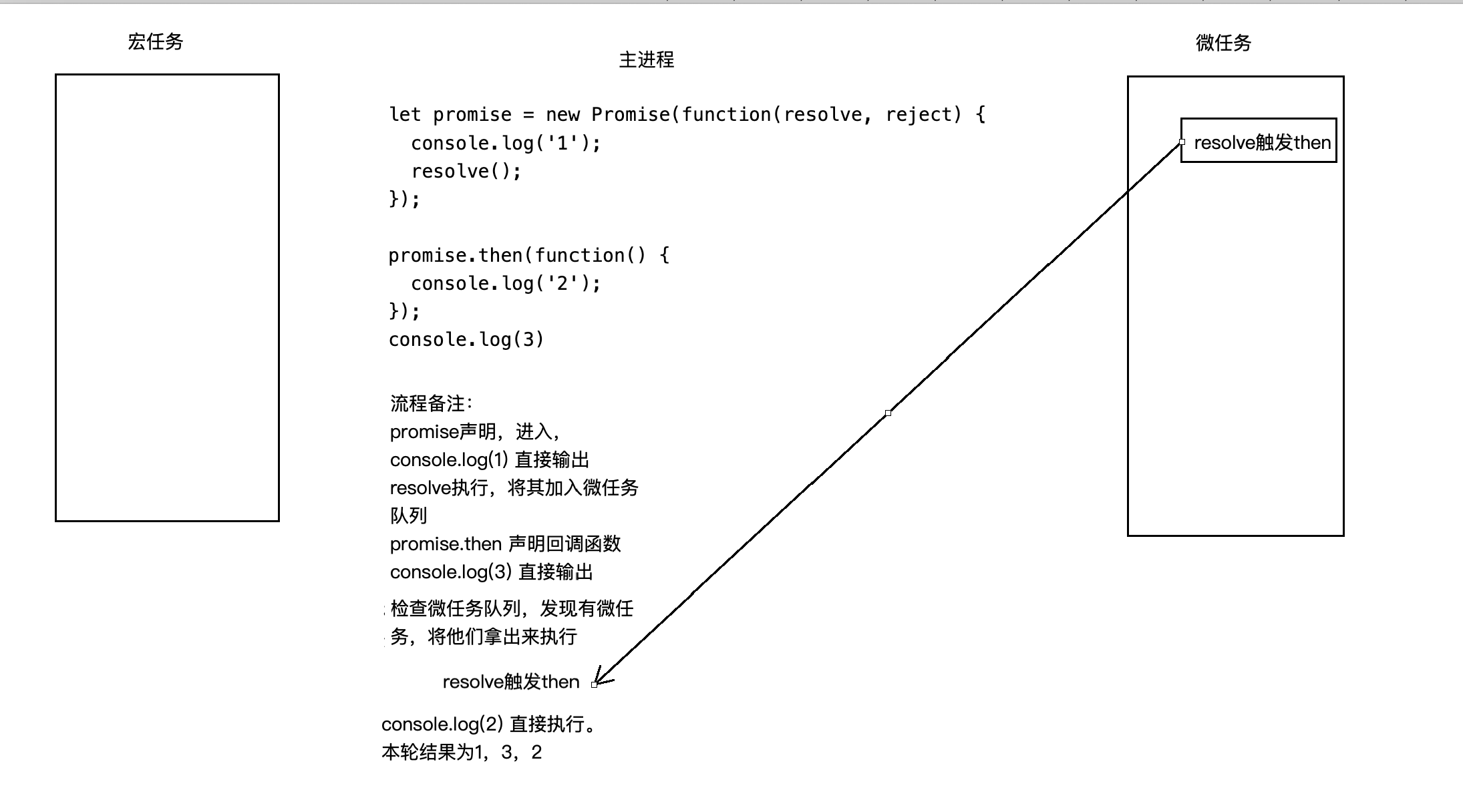
檢查巨集任務佇列發現為空,所以本次程式碼結束
答案為:1,3,2
```
console.log(1);
setTimeout(function(){
console.log(2);
}, 0);
Promise.resolve().then(function(){
console.log(3);
}).then(function(){
console.log(4);
});
```
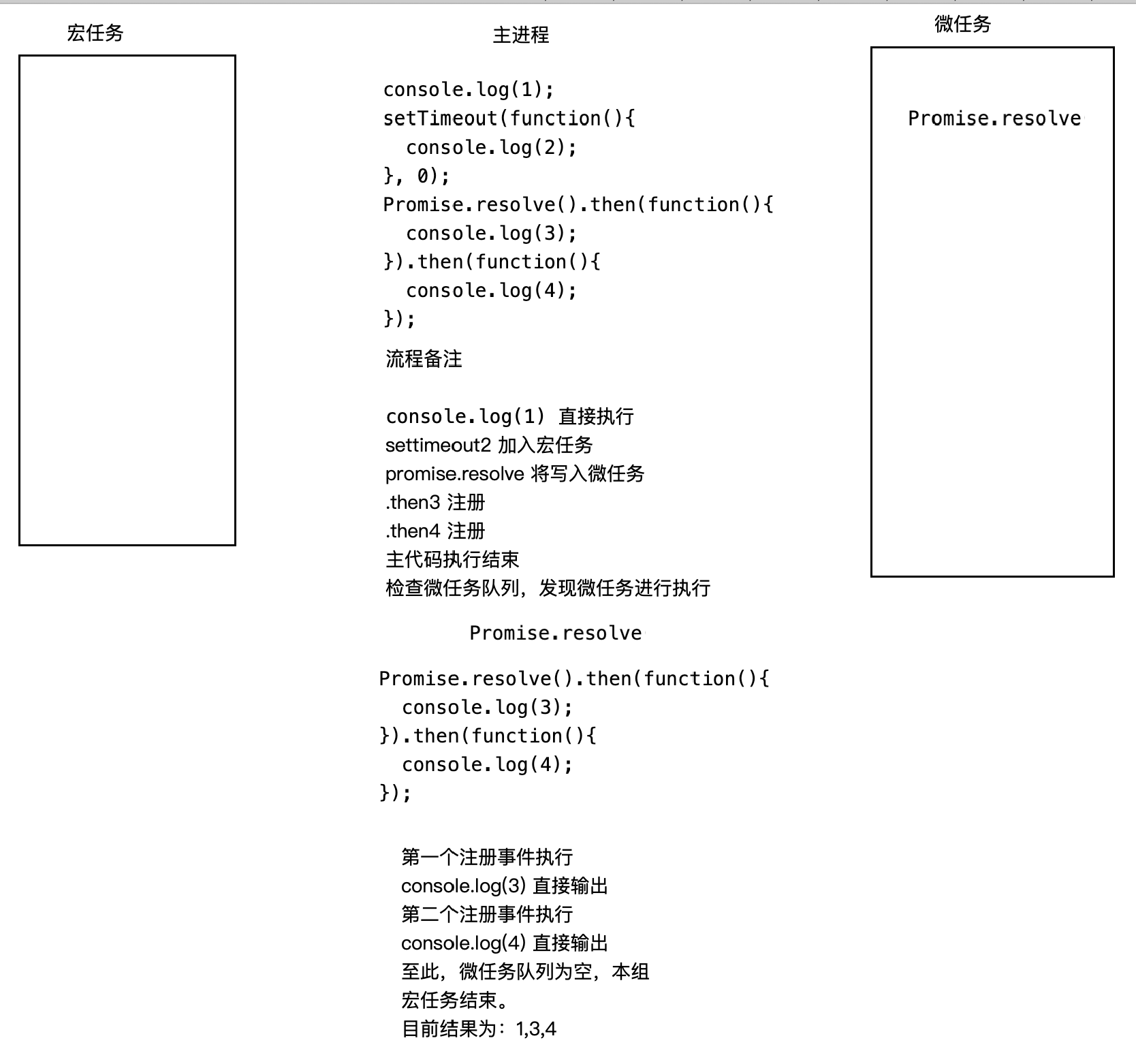
當前巨集任務已經結束,檢視巨集任務佇列中發現還有settimeout沒有執行,將它取出來執行,
輸出2.
所以本題答案為:1,3,4,2
```
setTimeout(()=>{
console.log('1');
},0);
var obj={
func:function () {
setTimeout(function () {
console.log('2')
},0);
return new Promise(function (resolve) {
console.log('3');
resolve();
})
}
};
obj.func().then(function () {
console.log('4')
});
console.log('5');
```
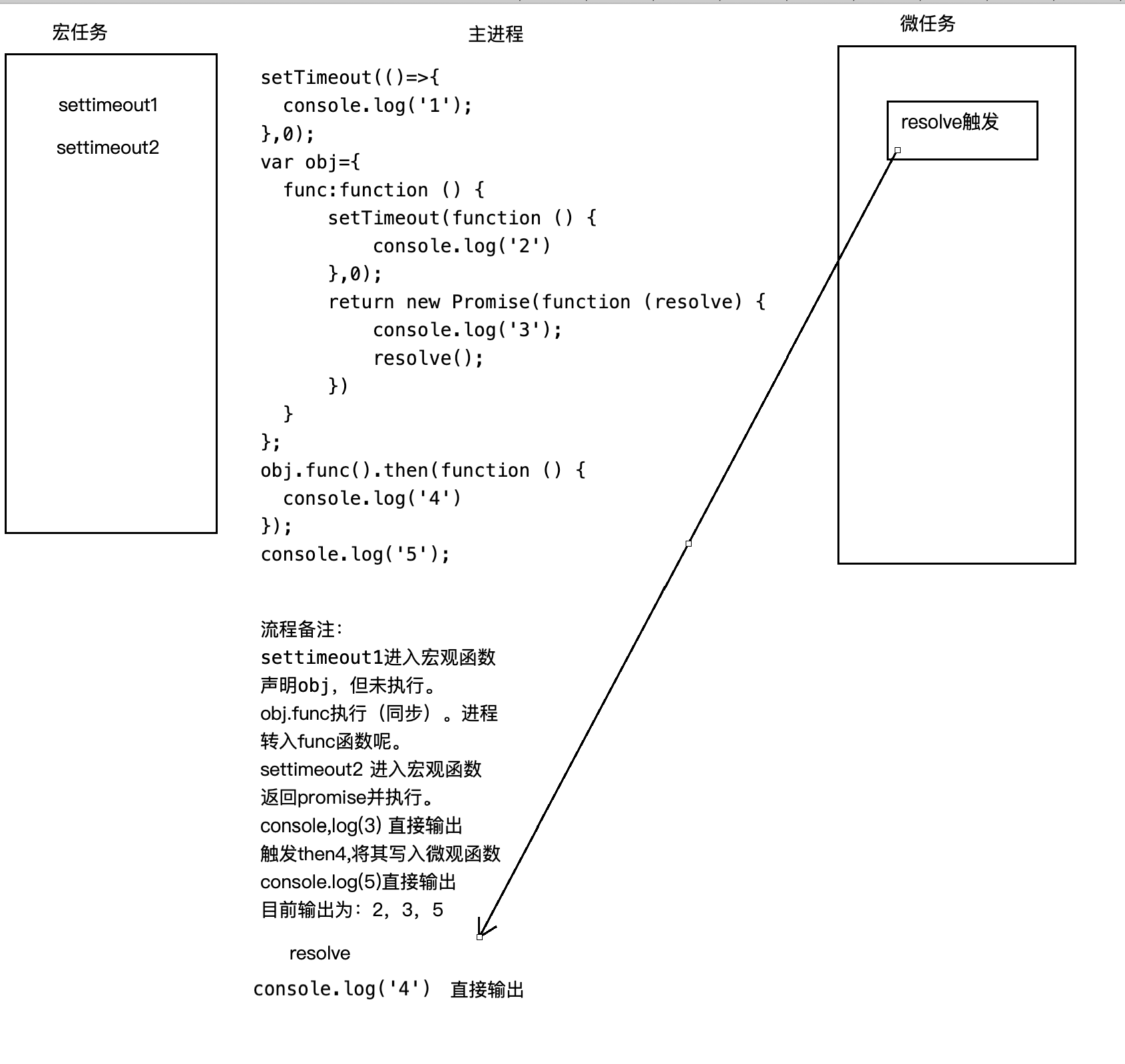
主線程序及其微觀程序執行完畢,會拿出下一組settimeout1執行,執行後會進行檢測微觀佇列,如果沒有則會繼續往下取出settimeout2執行。至此程式結束。
所以本題答案為:3,5,4,1,2
```
console.log(1)
const p = new Promise(function(resolve, reject) {
console.log(2)
resolve()
}).then(() => {
console.log(3)
throw(new Error('錯誤'))
}).catch(() => {
console.log(4)
})
console.log(5)
setTimeout(() => {
console.log(6)
}, 0);
console.log(7)
p.then(() => {
console.log(8)
throw(new Error('錯誤2'))
})
```
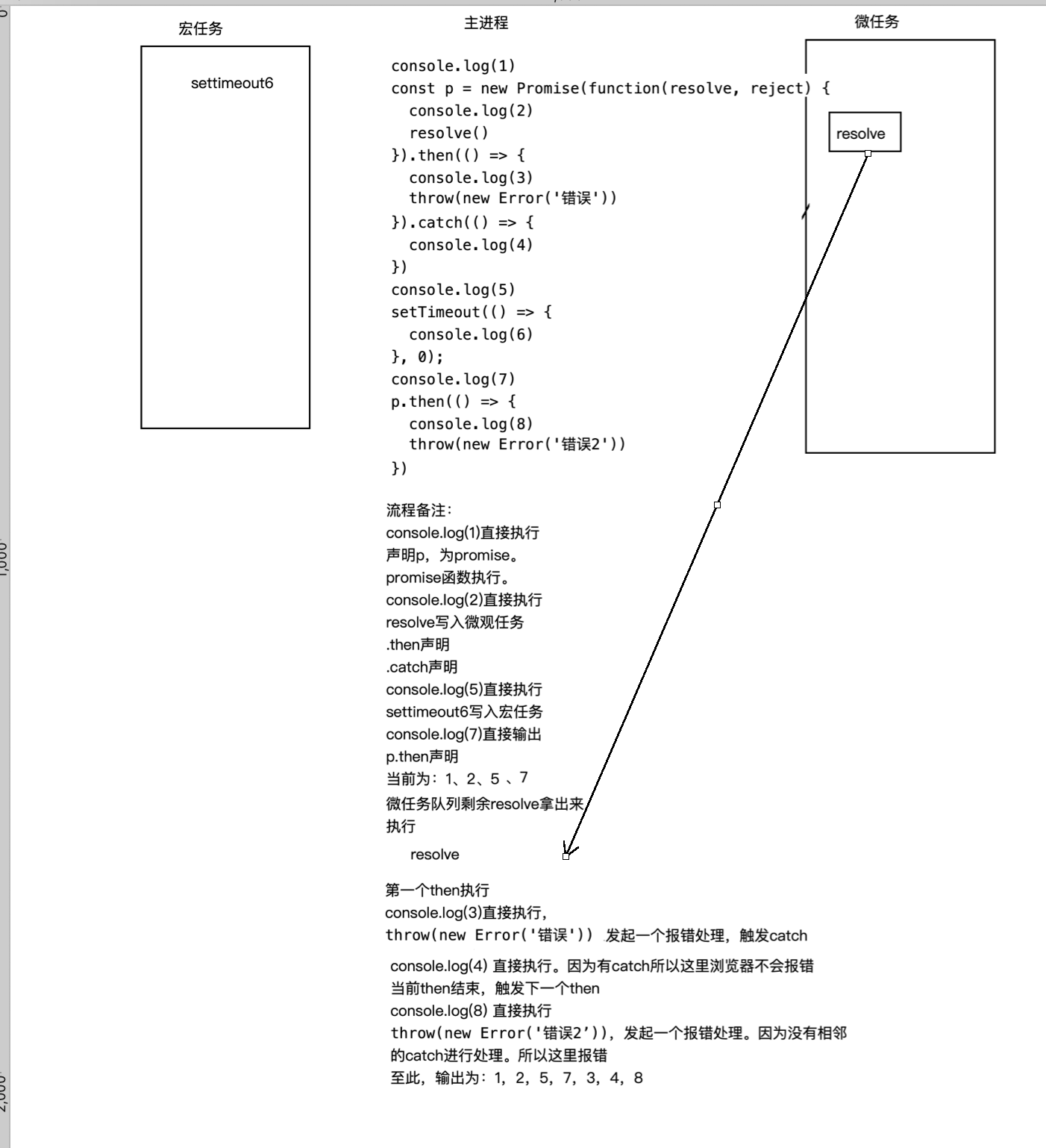
至此,當前巨集任務結束。檢查巨集任務佇列。取出下一組巨集任務,settimeout6,並執行
所以答案為:1,2,5,7,3,4,8,Error,6
最後留兩道題給大家做學習用。
如果不能一眼看出。可以像我一樣畫一個圖。進行梳理。本文中為了程式碼整齊,settimeout都是直接簡化為儘快執行。其實settimeout應該是在到達他宣告的時間時候,才進入巨集觀佇列排隊的。
根據以下規則,你將不會在遇到事件佇列的問題
1. 一次處理一個任務
2. 巨集任務+當前所有微任務為一組
3. 同步直接執行、非同步會加入事件佇列
4. 所有非同步的加入佇列時間均以他們觸發時間為準
```
console.log(1)
const p = new Promise(function(resolve, reject) {
console.log(2)
setTimeout(() => {
console.log(9)
}, 0);
resolve()
}).then(() => {
console.log(3)
throw(new Error('錯誤'))
}).catch(() => {
console.log(4)
})
console.log(5)
setTimeout(() => {
console.log(6)
}, 0);
console.log(7)
p.then(() => {
console.log(8)
throw(new Error('錯誤2'))
})
```
```
console.log(1)
const p = new Promise(function(resolve, reject) {
console.log(2)
setTimeout(() => {
console.log(9)
}, 0);
resolve()
}).then(() => {
console.log(3)
throw(new Error('錯誤'))
}).catch(() => {
console.log(4)
})
console.log(5)
setTimeout(() => {
console.log(6)
}, 0);
console.log(7)
p.then(() => {
console.log(8)
throw(new Error('錯誤2'))
})
requestAnimationFrame(function() {
console.log(10)
})
```
# 巨集觀微觀
## 巨集觀微觀不是巢狀!!!!!即使程式碼嵌套了在佇列中也不是巢狀的!!!!
怎麼利用這些,在程式碼中優化自己的程式碼,舉個例子來說
```
for (let i = 0 ; i<50000;i++) {
const div = document.createElement('div')
div.innerText = i
document.body.appendChild(div)
}
```
```
function slice(startSplitNumber, total, sliceNumber, cb) {
const oneNumber = total/sliceNumber
const start = startSplitNumber * oneNumber
const end = (startSplitNumber + 1) * oneNumber
if (start >
